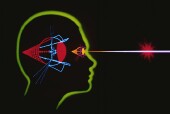
TUESDAY, Sept. 21 (HealthDay News) — As people crowd into theaters for the latest wave of 3-D movies, everyone seems to be oohing and ahhing over the visual feast provided by Hollywood’s improved 3-D technology.
Well, almost everyone.
“There will be at least one person in the crowd who says, ‘What are you talking about? I didn’t see anything flying out at me.’ Or maybe they will say, ‘That movie actually made me a little nauseated,'” said Dr. Dominick Maino, a professor at the Illinois College of Optometry and the Illinois Eye Institute.
From 3 million to 9 million people in the United States have vision problems that keep them from enjoying such 3-D movies as Avatar and Toy Story 3, estimates the American Optometric Association. And as many as 56 percent of people between 18 and 38 years of age suffer from symptoms related to depth-perception problems.
These problems have to do with binocular vision, the ability to align both eyes on a target and combine the visual images from the two eyes into a single, three-dimensional perception.
“We have 3-D because we have two eyes in our head in slightly different places,” Maino explained. “When the brain puts two images together, that’s when we get the 3-D effect.”
“3-D is really our ability to judge distances,” he said. “It’s a real nice survival trait, so we could tell how far away that saber-toothed tiger is and have him for lunch rather than the other way around.”
Movies done in 3-D recreate this effect by feeding different images into each eye, Maino said. In the early days, 3-D glasses would have one red lens and one blue lens, and there would be one red image and one blue image on the screen separated by a little distance. One eye would be able to see only the red and the other only the blue, and the brain would fit them together to form an in-depth perception.
The technology today is more advanced. Now, 3-D is created using polarized lenses that pick up separate images or by timing the images between the two eyes. “One image will be placed on one eye and then very quickly the other image is placed in the other eye,” Maino said. “When the brain puts that together, it gives the sense of 3-D.”
However, people who are having problems with their binocular vision will either not be able to perceive the illusion of 3-D, or they will find that the movies or TV shows actually give them “visual hangover,” said Dr. Leonard Press, a spokesman for the American Optometric Association and optometric director of the Vision and Learning Center in Fair Lawn, N.J.
An association poll found that headaches, blurred vision and dizziness are the most common side effects from 3-D movies for people who have binocular vision difficulties. “After the movie, they’re a bit dizzy, and it takes them a while to get back to normal,” Press said.
Several different vision disorders could be the cause of the problem, including:
- Amblyopia, or lazy eye, which occurs when one eye does not see as well as the other. “Because of that difference between the two eyes, the ability to see 3-D is greatly reduced or absent,” Maino said.
- Strabismus, or crossed eyes, in which the eyes do not line up in the same direction when focusing. Ultimately, a person with strabismus begins to suffer from double vision or loses the ability to see in 3-D.
- Convergence insufficiency, in which the eyes are incapable of turning toward each other to fix on the same distance.
Any of these can be treated by an optometrist or ophthalmologist. In fact, Maino said, the new 3-D movies are giving some people their first clue of a vision problem they may have had for a long time without recognizing it.
The problems, though, can be treated using optometric vision therapy, in which eye patches or special pairs of glasses are utilized to teach the eyes how to work together, Press and Maino said. Some of the techniques already are used to help kids with amblyopia or strabismus.
“It’s a form of physical therapy for the eyes,” Press said. “The key is helping your eyes work together with your brain. You do different activities that help both eyes work together. It’s almost like lifting weights.”
By the end of vision therapy, “we should have someone who has single, clear, two-eyed vision,” Maino said.
More information
The U.S. National Library of Medicine has more on vision problems.

